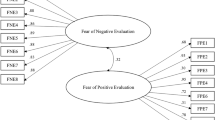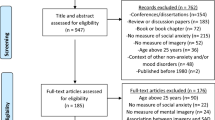Abstract
There are important applied and theoretical reasons for research into the association between social desirability and self-reported anxiety in young people. The aim of this study was to examine the relationship between anxiety and social desirability in a large normative sample of 7- to 14-year-olds (N = 1,786). Participants completed the Revised Children's Manifest Anxiety Scale and their teachers rated children as anxious-not anxious according to specified descriptions. Results indicated that anxiety and lie scores do not correlate for either gender or age grouping. However, anxiety scores interacted with lie scores differently for males and females in terms of the agreement between children's and teacher's ratings of anxiety. Indications are that social desirability levels may in part explain the consistent discrepancies found between child and adult reports of anxiety in young people.
Similar content being viewed by others
REFERENCES
American Psychiatric Association. (1980). Diagnostic and statistical manual of mental disorders (3rd ed.). Washington, DC: Author.
American Psychiatric Association. (1994). Diagnostic and statistical manual of mental disorders (4th ed.). Washington, DC: Author.
Boehnke, K., Silbereisen, R. K., Reynolds, C. R., & Richmond, B. O., (1986). What I think and feel: German experience with the Revised form of the Children's Manifest Anxiety Scale. Personality and Individual Differences, 7, 553-560.
Dadds, M. R., Spence, S. H., Holland, D., Barrett, P. M., & Laurens, K. (1997). Early intervention and prevention of anxiety disorders: A controlled study. Journal of Consulting and Clinical Psychology.
Davis, P. J. (1987). Repression and the inaccessibility of affective memories. Journal of Personality and Social Psychology, 53, 585-593.
Davis, P. J. (1991). Gender differences in autobiographical memory for childhood emotional experiences. Paper presented to the NATO Advanced Research Workshop on Theoretical Perspectives on Autobiographical Memory, Cumbria, England.
Ferrando, P. J. (1994). Factorial structure of the Revised Children's Manifest Anxiety Scale in a Spanish sample. Personality and Individual Differences, 16, 693-699.
Fritz, G. K., Spirito, A., & Yeung, A. (1994). Utility of the repressive defense style construct in childhood. Journal of Clinical Child Psychology, 23, 306-313.
Hagborg, W. J. (1991). The Revised Children's Manifest Anxiety Scale and social desirability. Educational and Psychological Measurement, 51, 423-427.
Hagborg, W. J. (1992). Prevalence and correlates of self-reported depressive mood among seriously emotionally disturbed adolescents. Psychological Reports, 70, 23-26.
Joiner, T. E., Schmidt, K. L., & Schmidt, N. B. (1996). Low-end specificity of childhood measures of emotional distress: Differential effects for depression and anxiety. Journal of Personality Assessment, 67, 258-271.
Mattison, R. E., Bagnato, S. J., & Brubaker, B. H. (1988). Diagnostic utility of the Revised Children's Manifest Anxiety Scale. Journal of Anxiety Disorders, 2, 147-155.
Perrin, S, & Last, C. G. (1992). Do childhood anxiety measures measure anxiety? Journal of Abnormal Child Psychology, 20, 567-578.
Reynolds, C. R., & Paget, K. D. (1981). Factor analysis of the Revised Children's Manifest Anxiety Scale. Journal of Consulting and Clinical Psychology, 49, 352-359.
Reynolds, C. R., & Paget, K. D. (1983). National normative and reliability data for the Revised Children's Manifest Anxiety Scale. Journal of Consulting and Clinical Psychology, 49, 352-359.
Reynolds, C. R., & Richmond, B. O. (1979). What I think and feel: A revised measure of children's manifest anxiety. Journal of Abnormal Child Psychology, 6, 271-280.
Richmond, B. O., Rodrigo, G., & Rodrigo, M. (1988). Factor structure of a Spanish version of the Revised Children's Manifest Anxiety Scale. Journal of Personality Assessment, 43, 281-283.
Silverman, W. K. (1994). Structured diagnostic interviews. In T. H. Ollendick, N. J. King, & W. Yule (Eds.), International handbook of phobic and anxiety disorders in children and adolescents (pp. 293-315). New York: Plenum Press.
Singer, J. L. (ed). (1990). Repression and dissociation: Implications for personality theory, psychopathology, and health. Chicago: University of Chicago Press.
Weinberger, D. A. (1990). The construct validity of the repressive coping style. In J. L. Singer (Ed.). (1990). Repression and dissociation: Implications for personality theory, psychopathology, and health. Chicago: University of Chicago Press.
Wilson, D., Chibaiwa, D., Majoni, C., Masukume, C., & Nkoma, E. (1990). Reliability and factor structure of the Revised Children's Manifest Anxiety Scale in Zimbabwe. Personality and Individual Differences, 11, 365-369.
Author information
Authors and Affiliations
Rights and permissions
About this article
Cite this article
Dadds, M.R., Perrin, S. & Yule, W. Social Desirability and Self-Reported Anxiety in Children: An Analysis of the RCMAS Lie Scale. J Abnorm Child Psychol 26, 311–317 (1998). https://doi.org/10.1023/A:1022610702439
Issue Date:
DOI: https://doi.org/10.1023/A:1022610702439




